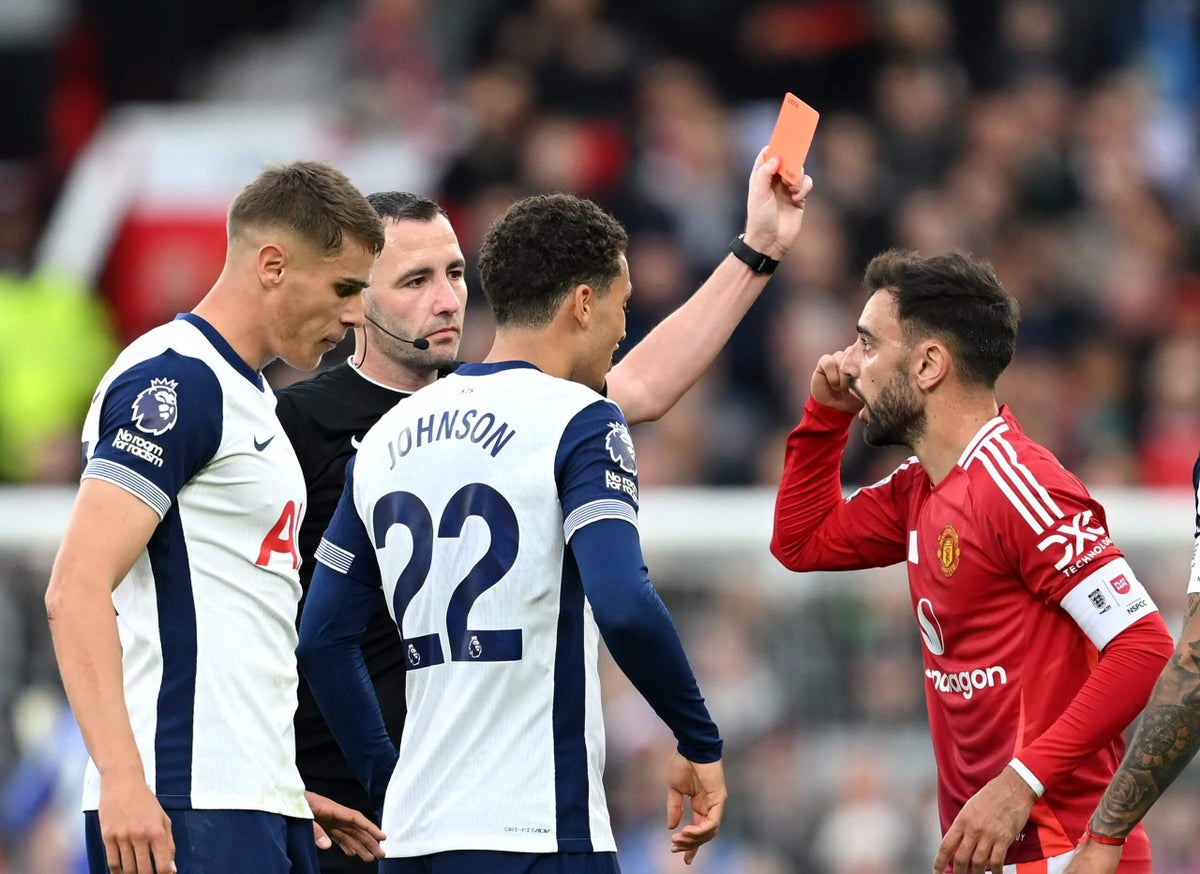Bruno Fernande’s farce proves why the VAR system should be abolished

How many layers of referees and re-referees does English football need before it can make the right decision?
When Bruno Fernandes stretched out to tackle James Maddison at Old Trafford on Sunday, slipped and then caught him with his studs, referee Chris Kavanagh quickly produced a red card for serious foul play.
Video assistant referee (VAR) Peter Bankes was then given the opportunity to review the decision using footage that Kavanagh – whose view was blocked by Manuel Ugarte and Cristian Romero – did not have. But Bankes chose not to intervene, seemingly convinced the threshold for overturning the decision had not been reached on the pitch. Kavanagh’s decision stood and Fernandes had to leave.
And yet, when Manchester United subsequently appealed Fernandes’ red card, the FA’s disciplinary committee, made up of three former players, upheld their claim that the red card was wrong. Fernandes will be available to play in United’s next three matches.
You will all have your own opinion on whether or not Fernandes should have been sent off. At first glance it looked high-minded, dangerous and cynical. On slow-motion replays, it’s clear that Fernandes slipped instead of diving in. He extended his leg to catch Maddison, but did so with his heel on Maddison’s shin, with little force. The risk to Madison was low. Fernandes told Sky Sports afterwards that Maddison himself had told him it was a foul, but “never a red card”.

Bruno Fernandes’ red card was a marginal decision (Michael Regan/Getty Images)
But the point is that people can reasonably disagree in good faith about whether it was a red card or not. There is no right or wrong answer here. And so the two different review processes – first the VAR on the day itself, and then the disciplinary committee two days later – can look at the same footage and come to different conclusions. Kavanagh’s decision fell into a rare marginal space: good enough not to be overturned by VAR, but not good enough to survive the three-man committee. This is before we even hear from the Major Match Incidents panel, which will likely take a position on the decision this week.
It’s enough to make you wonder again what the point of the VAR system is. The whole intellectual basis of VARs is that with enough time and technology, mistakes made on the pitch can be corrected. That there is at least an objectively correct decision and that with enough slow-motion repetitions, the wrong decisions can be replaced with right ones. Even if the percentage of errors made by referees on the pitch is small, VARs offer us the attractive opportunity to move towards 100 percent accuracy. Who could ever be against that?

GO DEEPER
VAR explained: What is it? Why is it controversial? How can the Premier League put this behind them?
And yet the events of the past few days show us how flawed that logic is. The fact that people will disagree on whether or not Fernandes should have been sent off shows that the idea of objectively correct decisions is a fantasy. The fact that Bankes viewed the footage and subsequently confirmed Kavanagh’s decision shows that the technology itself is not a panacea. And the fact that a committee can then overturn not only the referee’s decision, but actually the VAR, shows that the idea of a VAR settling or ending these debates was always ridiculous.
Football has been pursuing the goal of complete accuracy in decisions for years. And yet everything we have seen since the advent of the VAR system has shown this to be an impossible dream. So many decisions, especially those involving serious foul play, are so subjective that no amount of forensic re-examination will ever get you to the truth. The final decision on Fernandes is no less controversial than the decisions of Kavanagh or Bankes.
Think for a moment how much we have lost in pursuit of this mirage. The fan experience at games has been irrevocably damaged. The simple link between the ball hitting the back of the net and the joy of celebration is broken; or rather, it has been replaced by minutes of waiting in limbo, stranded in the dark, often with no idea what is going on. By the time the goal is given or not, the moment is lost. The moments you live for as a fan, travel for, pay exorbitant prices for, are now so mediated by Stockley Park that they have lost their emotional edge. The price far outweighs the price.

VAR has sucked the joy out of goal celebrations (Marc Atkins/Getty Images)
This is the point where the enthusiastic defenders of the VAR system will say: no, the problem is not the technology, but rather the people using it, and that if they can simply be better trained, the dream of total objective accuracy will still be possible. always exists. within reach.
This has always been a ridiculous argument. Everything we know about football – and about people – tells us that there is no such thing as a set of unrevealed correct answers. And that no person or panel, no matter how many replays they had access to, could ever reveal it. No bespoke VAR training regime could fill the emotional void while you wait to find out whether your team’s stoppage time winner is allowed or not.
Any argument about tweaking, improving or adapting the VAR system only serves to accept the premise of the technology, to accept the damage it has done to our game and to put an academic fantasy over the lived experience of fans to elevate. There is no longer any accommodation possible with VAR, which requires so much more than it delivers. There’s only one argument fans should make from here: complete abolition now.
When the Premier League clubs voted on it in June, only Wolverhampton Wanderers was clear enough to take that position. History will judge them kindly for being brave enough to stick their necks out in defense of what is right. Perhaps it will take a few extra layers of the review process, and a few new officials trying to find different answers to the same questions, before the rest of the clubs see what is staring everyone else in the face.
(Top photo: Michael Regan/Getty Images)




